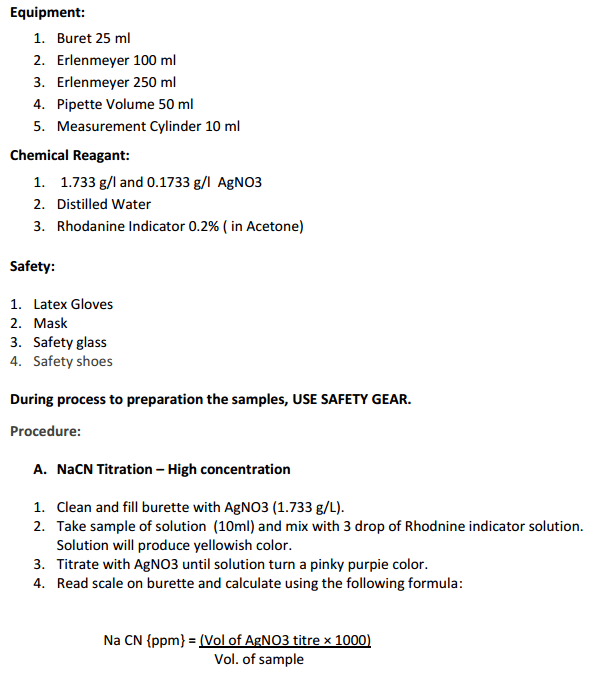 Titration of Cyanide Solutions Containing Dissolved Zinc: Sodium zinc cyanide reacts with silver nitrate to precipitate zinc cyanide:
Titration of Cyanide Solutions Containing Dissolved Zinc: Sodium zinc cyanide reacts with silver nitrate to precipitate zinc cyanide:
Na2Zn(CN)4 + AgNO3 =
Zn(CN)2 + NaAg(CN)2 + NaNO3
In the presence of an alkali, considerably more silver nitrate must be added to sodium zinc cyanide before a precipitate is formed. Many investigators have claimed that this is because the alkali reacts with sodium zinc cyanide to produce sodium cyanide and sodium zincate:
Na2Zn(CN)4 + 4 NaOH =
4 NaCN + Na2ZnO2 + 2 H2O
and that the silver nitrate reacts with the liberated sodium cyanide. On this basis it has further been stated that the cyanide thus combined with zinc can be reclaimed or regenerated by the addition of sodium hydroxide and that this cyanide is equally as effective in cyanidation as the original sodium cyanide. Observation, however, indicates that this is unlikely because the reverse reaction would undoubtedly take place to a considerable extent, i.e., sodium cyanide would react with sodium zincate to form sodium zinc cyanide. What probably takes place is that the zinc cyanide first precipitated by the silver nitrate dissolves immediately in the sodium hydroxide to form sodium zinc cyanide and sodium zincate; if sufficient alkali is present, the silver nitrate will continue to react with the sodium zinc cyanide thus formed until all of the zinc is converted to soluble zincate and all of the cyanide is combined with silver. The reactions may be represented thus:
Na2Zn(CN)4 + AgNO3 =
Zn(CN)2 + NaAg(CN)2 + NaNO3
Zn(CN)2 + 2 NaOH =
0.5 Na2Zn(CN)4 + 0.5 Na2ZnO2 + H2O
As more silver nitrate is added, these reactions continue to completion giving the overall reaction represented by the equation:
Na2Zn(CN)4 + 4 NaOH + 2 AgNO3 =
2 NaAg(CN)2 + Na2ZnO2 + 2 NaNO3 + 2 H2O
The end of the reaction is indicated by the formation of a white opalescent precipitate of silver cyanide formed as soon as a slight excess of silver nitrate reacts with sodium silver cyanide:
NaAg(CN)2 + AgNO3 = 2 AgCN + NaNO3
If potassium iodide be present, which is the usual practice when titrating a cyanide solution with silver nitrate, instead of a white precipitate of silver cyanide indicating the end of the reaction, a yellow precipitate of silver iodide indicates the endpoint; the latter is more distinctive.
The foregoing discussion has been limited to the effect of sodium or potassium hydroxide on the reaction between silver nitrate and sodium zinc cyanide. The use of alkali metal hydroxides in practice is not common, however. The most commonly used alkali in cyanidation is hydrated lime. Due to its limited solubility, cyanide solutions never carry more than about 0.12 percent CaO but it is not always necessary or desirable to maintain mill solutions at this strength throughout an entire circuit. In fact, mill solutions carrying less than 0.02 percent CaO are not unusual. Experiments have been run to determine the effect of lime solutions of practical strength on the reaction between sodium zinc cyanide and silver nitrate. The procedure was as follows:
A known amount of sodium cyanide was dissolved in water and more than sufficient zinc cyanide, Zn(CN)2, to react with all of the sodium cyanide was added. The solution was agitated on rolls for 5 hours after which the excess zinc cyanide was filtered off. An analysis of the filtrate showed it to contain 0.319 percent total NaCN equivalent and 0.110 percent zinc. Thus, the composition of the sodium zinc cyanide formed corresponded closely to the formula, Na2Zn(CN)4. Equal volumes of this solution were measured out and a known but different amount of dry calcium hydroxide added to each portion. The solutions, in stoppered bottles, were agitated on rolls until the lime dissolved. One portion of each solution was titrated with silver nitrate to the first appearance of white opalescence. This was taken as one end-point, although it was very vague and indefinite. Another portion of each was titrated with silver nitrate using potassium iodide as an indicator. The typical yellow color of silver iodide was taken as another end-point. ‘The white opalescence or precipitate obtained before reaching this end-point was disregarded. In this case the end-point was fairly definite but masked to some extent by the white precipitate.
The amount of silver nitrate required to produce the respective endpoints is given in terms of percent apparent free NaCN. In other words, this series of tests shows how much of the cyanide combined in Na2Zn(CN)4 reports as free cyanide under various conditions of lime alkalinity, and with different types of end-points. From the results it may be noted that the percentage of apparent free NaCN varies according to the specific endpoint taken. A much greater amount of silver nitrate was required when potassium iodide was used as an indicator than when no potassium iodide was used, i.e., when the first appearance of white opalescence was taken as the end-point. As the lime content of the solutions increased, the amount of silver nitrate required to give the respective end-points increased. When the solution contained 0.13 percent CaO and when potassium iodide was used as an indicator, all of the cyanide in sodium zinc cyanide reported as free cyanide, and in a solution containing 0.021 percent CaO, 60 percent of the combined cyanide reported as free cyanide. Thus, lime acts in the same way as alkali metal hydroxides in that it permits the reaction between silver nitrate and sodium zinc cyanide to proceed to completion. It is apparent, therefore, that when a mill cyanide solution contains sodium zinc cyanide, and normal amounts of lime, the usual method for the determination of free cyanide will give a high result.


